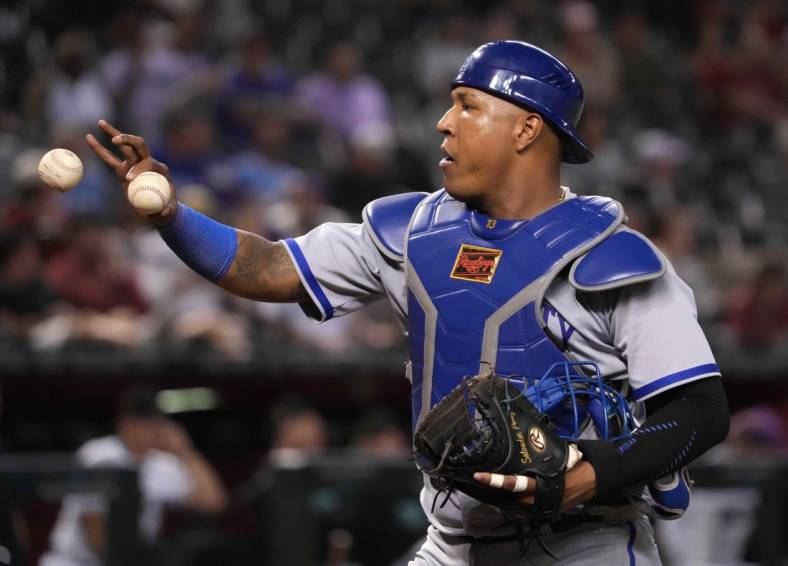
Major League Baseball is embracing tempo like never before, and that includes on the basepaths: the art of stealing has been reborn in 2023.
Sure, the pitch clock was added to speed up games, but MLB rule changes were not just designed to get ticketholders and viewers on to the next part of their day as soon as possible. The ambitious master plan was to create a tidier package that also included more excitement.
Baseball wanted to have its instant-recipe cake and make it more delicious, too.
Well, part of that equation does not look all that tasty to the New York Mets, whose catchers have an 8.3 percent success rate in throwing out basestealers this season. That is just two runners caught in 24 stolen base attempts, tied for the second-worst percentage in the majors.
It’s enough to get Mets manager Buck Showalter to consider hiring a counselor for each of his catchers.
“I’ll tell you, one of the jobs you have now is keeping your catchers from getting down on themselves,” Showalter said recently. “If you look at the times and you do the math of where (basestealers) are when they start and the momentum they have … this is what they want.”
The offense’s chances of stealing a base improved with the new limit of two times a pitcher can “disengage” from the rubber per plate appearance. Pickoff throws are included in the disengagements. Slightly enlarged bases also mean baserunners can reach the next bag a tick earlier.
A less-obvious assist to basestealers is not allowing pitchers to hold the ball for any length of time while on the mound as to give doubt if there would be a pickoff throw or a pitch to the plate. Baserunners now essentially know when the pitcher will go into action.
“Unless a pitcher is willing to get on the mound with 13 seconds left and know what pitch he’s going to throw, where he can hold the ball, these guys are going to continue to get running leads,” Showalter said. “It’s going to be hard for good catchers to throw them out.”
It’s a fair point, but the best way to offset that negative to steal more bases yourself. So that is what the Mets have done. Their 21 steals are tied for fourth in the National League. They have been caught stealing just three times, one of six teams with three or fewer.
So just how bad it is for opposing catchers these days? On average, not many teams are having it as hard as the Mets, although the success rate for basestealers is up in the early going.
Catchers are throwing out basestealers at a 20.6 percent success rate nearly a month into the season. That is down from 24.6 percent last season. But the success rate for catchers has been on a steady decline ever since masked men threw out 40.7 percent of basestealers in 1967.
In 2000, catchers threw out 31.2 percent of basestealers, with that figure dropping under 30 percent by 2004.
As analytics valued a potential run over the possible out by getting caught stealing, stolen bases dwindled to 0.46 per game in 2021 — the lowest average since 1971. But they are up to 0.69 per game this season, the highest figure since it was at 0.70 in 1999.
Yet not all catchers are taking the duck-for-cover approach. Veteran Kansas City Royals backstop Salvador Perez says he is enjoying the rule changes so far.
“Believe it or not, I think it’s easier for the catcher because if the pitcher changes the (delivery) time — going at eight seconds (left on the clock), or sometimes waiting until one second, or sometimes going at 13 or whenever they are ready — It’s hard for the guys trying to steal,” Perez said. “They aren’t going to have the specific time to go. The problem is that if you throw over two times, the third time has to be an out or you know he’s going to get second base.”
Perez, a seven-time All-Star and five-time Gold Glove winner, called the increased success rate for basestealers a small sample size and suggested the numbers would swing back toward the catchers as the season progresses. In fact, catcher success rate was at 18 percent when he said as much last weekend, and it improved in a matter of days.
Perez does admit to a biased view at the numbers, though. He is loving the faster games. At age 32, he is more aware than ever that all players have an expiration date. His, though, might be extended a bit longer.
“I think to speed up the game will add to my career two more years behind the plate,” said Perez, whose current contract goes through 2025, with a 2026 club option, but now is thinking about 2027. “Before, we would play 3 hours, 45 minutes. Now it’s 2 hours and 45 minutes at the most. We played a game the other day at home in 2 hours and 2 minutes. … It takes an hour off my body (each night) to be behind home plate.”
–Doug Padilla, Field Level Media